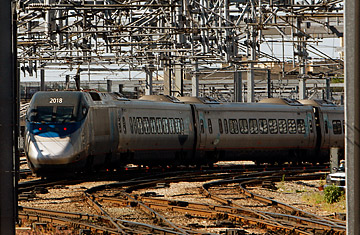
An Amtrak Acela Express train in Boston, Massachusetts.
The Republican governors-elect of Wisconsin and Ohio have both pledged to shut down the federal high-speed rail initiatives in their states. Today, the Obama administration is beating them to the punch.
Transportation Secretary Ray LaHood announced this afternoon that he will redirect about $1.2 billion in high-speed grants from Wisconsin and Ohio to a dozen other states that want to continue their programs. California and Florida, the big winners in last year's grant competition, will get the bulk of the redistributed money as well, up to $624 million and $342 million respectively; Washington ($161 million) and Illinois ($42 million) will get most of the rest.
"I am pleased that so many other states are enthusiastic about the additional support they are receiving to help bring America's high-speed rail network to life," LaHood said.
Obama launched the national high-speed rail program with $8 billion in his stimulus bill, plus another $2.5 billion in last year's budget. The idea is to upgrade America's woeful passenger rail network with sleek new bullet trains — starting with a line between Tampa and Orlando and another between San Francisco and Los Angeles — as well as faster Amtrak service on existing lines. Trains topping 200 miles per hour are common in Europe and Asia, and are now under construction in countries like Brazil and Saudi Arabia.
Wisconsin had received $810 million for a new Milwaukee-Madison train, a proposed link in an eventual Chicago-Minneapolis line; Governor-Elect Scott Walker vowed to block construction to avoid future upkeep costs; his campaign actually launched a notrain.com website to rally opposition. Ohio had received $400 million for a new "3-C" line linking Columbus, Cincinnati and Columbus, but Governor-Elect John Kasich trashed it as a slow-speed boondoggle that would only average 39 miles per hour in its initial phase. Walker and Kasich had talked about using the rail money on roads and bridges in their own states, but LaHood, a former Republican congressman, has made it clear that's not an option.
Florida GOP Governor-Elect Rick Scott has also expressed some reservations about high-speed rail, suggesting that he doesn't want the state to have to pay for the 84-mile Tampa-Orlando line. But now he might not have to; with the infusion of cash from the Badger and Buckeye states, the feds have now contributed over 90% of the estimated $2.6 billion cost.
High-speed rail never used to be a partisan issue, but its inclusion in Obama's controversial stimulus package has made it a kind of proxy issue; Democrats call it a "wise investment," while Republicans call it "big spending," and talk about rescinding unspent money. Wisconsin's outgoing Democratic governor, Jim Doyle, was always enthusiastic about the program as a source of employment as well as mobility; the Spanish firm Taigo manufactures trains in Wisconsin. But Walker insisted that his administration would not spend a dime to maintain the train, even though the federal government was shouldering the costs of building it.
"I am sure that you share my disappointment that Wisconsin will not benefit from federal high-speed rail dollars at this time," Federal Railroad Administrator Joe Szabo wrote in his termination letter to Doyle. "But I hope that as a staunch supporter of high-speed rail you will appreciate that the funds will be redirected to other states eager to develop high-speed rail corridors and put people back to work in good-paying jobs."
